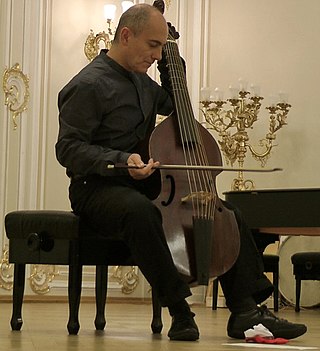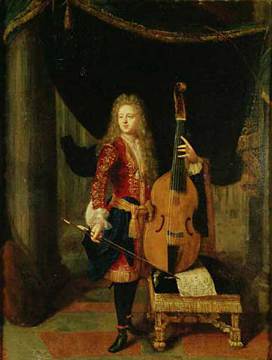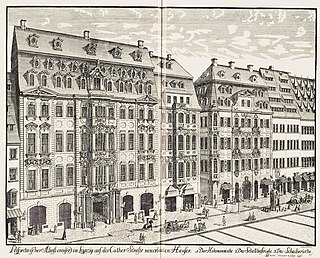Related Research Articles

Carl Friedrich Abel was a German composer of the pre-Classical era. He was a renowned player of the viola da gamba, and produced significant compositions for that instrument. He was director of music at the Dresden court from 1743, and moved to London in 1759, becoming chamber-musician to Queen Charlotte in 1764. He founded a subscription concert series there with Johann Christian Bach. According to the Catalogue of Works of Carl Friedrich Abel (AbelWV), he left 420 compositions, with a focus on chamber music.

The viola da gamba, or informally gamba, is any one of a family of bowed, fretted, and stringed instruments with hollow wooden bodies and pegboxes where the tension on the strings can be increased or decreased to adjust the pitch of each of the strings. Although treble, tenor and bass were most commonly used, viols came in different sizes, including pardessus, treble, alto, small tenor, tenor, bass and contrabass. Separating these from other bowed string instruments such as the viola da braccio was the instruments' orientation; members of the older viol family were played with the neck oriented upwards, the rounded bottom downwards to settle on the lap or between the knees.

The Brandenburg Concertos by Johann Sebastian Bach are a collection of six instrumental works presented by Bach to Christian Ludwig, Margrave of Brandenburg-Schwedt, in 1721. The original French title is Six Concerts Avec plusieurs instruments, meaning "Six Concertos for several instruments". Some of the pieces feature several solo instruments in combination. They are widely regarded as some of the greatest orchestral compositions of the Baroque era.
Bowed string instruments are a subcategory of string instruments that are played by a bow rubbing the strings. The bow rubbing the string causes vibration which the instrument emits as sound.

The lirone is the bass member of the lira family of instruments that was popular in the late 16th and early 17th centuries. It is a bowed string instrument with between 9 and 16 gut strings and a fretted neck. When played, it is held between the legs in the manner of a cello or viol.

Hille Perl is a German virtuoso performer of the viola da gamba and lirone.

Paolo Pandolfo is an Italian virtuoso player, composer, and teacher of music for the viola da gamba, born on January 31, 1964.

Vittorio Ghielmi is an Italian musician, conductor, composer. Compared by critics to Jasha Heifetz ("Diapason") for his virtuosity, and described as "An Alchemist of sound" for the intensity and versatility of his musical interpretations, Vittorio Ghielmi attracted notice while still very young for his new approach to the viola da gamba and to the sound of early music repertoire. His multifaceted training has made him an appreciated and creative musician as well as a sought-after conductor and coach for modern orchestras or orchestras with original instruments. He is Professor for viola da gamba and Head of the Department für Alte Musik at the Mozarteum Universität Salzburg and visiting professor at the Royal College of London. He is graduate at the Università Cattolica di Milano. He was born in Milan, Italy, where as a child he began his study of music with the violin, the double bass and later the viola da gamba and composition. In 1995 he was the winner of the "Concorso Internazionale Romano Romanini per strumenti ad arco" (Brescia). His fieldwork within old musical traditions surviving in forgotten parts of the world and bringing new perspectives to the interpretation of European "early music" led to him being presented the "Erwin Bodky Award" . He studied the viol with Roberto Gini, Wieland Kuijken and Christophe Coin (Paris). Associations with instrument maker, engineer and humanist Luc Breton (CH) as well as with many musicians of non-European traditions have been fundamental to his musical career, creating a deeper reflexion on the nature of sound used in early and modern European tradition . As viola da gamba soloist or conductor, he has appeared with many of the world's most famous orchestras in the fields of both classical and ancient music. He performs since youth recitals in duos with his brother Lorenzo Ghielmi and with the lutenist Luca Pianca, in the most important halls. As soloist or chamber musician, he has shared the stage with artists such as Gustav Leonhardt (duo), Cecilia Bartoli, Andràs Schiff, Thomas Quasthoff, Mario Brunello, Viktoria Mullova, Giuliano Carmignola, Christophe Coin, Reinhard Goebel, Giovanni Antonini, Ottavio Dantone, Enrico Bronzi etc. He is one of the few viola da gamba players regularly invited to appear as a soloist-conductor with orchestra. He has been invited to play in the world première of many new compositions, many of which have been dedicated to him . From 2007 to 2011 he was assistant to Riccardo Muti at the Salzburg festival. In 2007 he conceived with the Argentinian singer Graciela Gibelli and conducted a show, based on Buxtehude's "Membra Jesu Nostri", with the American film maker Marc Reshovsky (Hollywood) and the Swedish choir "Rilke Ensemble" (G.Eriksson); the project was produced by the Semana de musica religiosa de Cuenca (Madrid) and brought later to the Musikfest Stuttgart in 2010. Over three nights in 2009, he gave a performance of Forqueray's complete works for viola da gamba at De Bijloke, Ghent (B). He has been artist in residence at Musikfest Stuttgart 2010, the Segovia festival 2011, and the Bozar Bruxelles 2011. In 2012 he conducted Handel's Water music at the Portogruaro Festival (Venice) with a spectacle on the river Lemene conceived by Monique Arnaud. In 2018 he conducted the Opera Pygmalion by Rameau at the Drottningholms Slottsteater (Stockholm), with the régie of Saburo Teshigawara.; the new conception of this spectacle was so described in the Financial Times : "In their new production for Drottningholm Slottsteater, the Japanese dancer and choreographer Saburo Teshigawaraand Italian conductor and viola da gamba player Vittorio Ghielmi create a genuine masterpiece which combines exquisite music-making with experimental dance and modern lighting effects with the theatre’s unique 18th-century stage technology. Indeed, it is some time since the theatre has been so marvellously and innovatively put to use.“
Jonathan Manson is a Scottish cellist and viol player. Born in Edinburgh, he studied cello with Jane Cowan and later went on to the Eastman School of Music in Rochester, NY, where he studied with Steven Doane and Christel Thielmann. He studied viola da gamba with Wieland Kuijken in The Hague.

Bass violin is the modern term for various 16th- and 17th-century bass instruments of the violin family. They were the direct ancestor of the modern cello. Bass violins were usually somewhat larger than the modern cello, but tuned to the same nominal pitches or sometimes one step lower. Contemporaneous names for these instruments include "basso de viola da braccio," "basso da braccio," or the generic term "violone," which simply meant "large fiddle." The instrument differed from the violone of the viol, or "viola da gamba" family in that like the other violins it had at first three, and later usually four strings, as opposed to five, six, or seven strings, it was tuned in fifths, and it had no frets. With its F-holes and stylized C-bouts it also more closely resembled the viola da braccio.
Laurence Dreyfus, FBA is an American musicologist and player of the viola da gamba who was University Lecturer and Fellow of Magdalen College, Oxford.

Johannes Schenck was a Dutch musician and composer.
August Wenzinger (1905–1996) was a prominent cellist, viol player, conductor, teacher, and music scholar from Basel, Switzerland. He was a pioneer of historically informed performance, both as a master of the viola da gamba and as a conductor of Baroque orchestral music and operas.

The Sonata in G major for two flutes and basso continuo, BWV 1039, is a trio sonata by Johann Sebastian Bach. It is a version, for a different instrumentation, of the Gamba Sonata, BWV 1027. The first, second and fourth movement of these sonatas also exist as a trio sonata for organ.

The sonatas for viola da gamba and harpsichord, BWV 1027–1029, are three sonatas composed by Johann Sebastian Bach for viola da gamba and harpsichord. They probably date from the late 1730s and early 1740s.

Philippe Pierlot is a Belgian viola da gamba player and a conductor in historically informed performance. He is also an academic teacher at the royal conservatories of The Hague and Brussels.

Georg Philipp Telemann's collection of Twelve Fantasias for Viola da Gamba Solo, TWV 40:26–37, was published in Hamburg in 1735, titled Fantaisies pour la Basse de Violle. The fantasias for viola da gamba were considered lost until an original print was found in a private collection in 2015. They were published by Edition Güntersberg in 2016, and first recorded and performed again by Thomas Fritzsch the same year.

Jonathan Dunford is an American violist specialising in the baroque repertoire.

Bettina Hoffmann is a German viola da gambist and cellist, musicologist, and music pedagogue. A specialist in Renaissance, and Medieval music, she is the leader of the Renaissance and Medieval ensemble of Modo Antiquo. She has an extensive discography, primarily on the Brilliant Classics and Tactus labels and participated in two Grammy-nominated recordings.

Viola da braccio is a term variously applied during the baroque period to instruments of the violin family, in distinction to the viola da gamba and the viol family to which the latter belongs. At first "da braccio" seems to encompass the entire violin family. Monteverdi's Orfeo designates an entire six-part string section "viole da brazzo", apparently including bass instruments held between the knees like the cello and bass violin. His Selva morale (1641) contains a piece calling for "due violini & 3 viole da brazzo ouero 3 Tronboni", reflecting a general shift in meaning towards the lower instruments. Eventually it came to be reserved for the alto member, the viola. A famous example is Bach's Sixth Brandenburg Concerto (1721), combining two viole da braccio with two viole da gamba. The German word for viola, Bratsche, is a relic of this last use.
References
- ↑ Ludwig, Loren (January 1, 2019). "THE VIOLA DA GAMBA IN EIGHTEENTH-CENTURY VIRGINIAAND MARYLAND: NEW AND RECONSIDERED EVIDENCE. | EBSCOhost". Journal of the Viola da Gamba Society of America. 2019 (51).